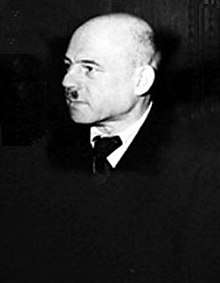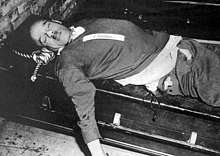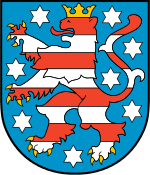Fritz Sauckel
Ernst Friedrich Christoph "Fritz" Sauckel (27 October 1894 – 16 October 1946) was a German Nazi politician, Gauleiter of Thuringia from 1927 and the General Plenipotentiary for Labour Deployment (Arbeitseinsatz) from March 1942 until the end of the Second World War. Sauckel was among the 24 persons accused in the Nuremberg Trial of the Major War Criminals before the International Military Tribunal. He was found guilty of war crimes and crimes against humanity, and was sentenced to death by hanging.
Fritz Sauckel | |
|---|---|
 Sauckel at the Nuremberg trials | |
| General Plenipotentiary for Labour Deployment | |
| In office 21 March 1942 – 8 May 1945 | |
| Gauleiter of Thuringia | |
| In office 30 September 1927 – 8 May 1945 | |
| Leader | Adolf Hitler |
| Preceded by | Artur Dinter |
| Reichsstatthalter of Thuringia | |
| In office 5 May 1933 – 8 May 1945 | |
| Minister President of Thuringia | |
| In office 26 August 1932 – 8 May 1933 | |
| Preceded by | Erwin Baum |
| Succeeded by | Willy Marschler |
| Acting Reichsstatthalter of the Free State of Anhalt | |
| In office 29 November 1935 – 19 April 1937 | |
| Prime Minister | Alfred Freyberg Rudolf Jordan |
| Preceded by | Wilhelm Friedrich Loeper |
| Succeeded by | Rudolf Jordan |
| Acting Reichsstatthalter of the Free State of Brunswick | |
| In office 29 November 1935 – 19 April 1937 | |
| Prime Minister | Dietrich Klagges |
| Preceded by | Wilhelm Loeper |
| Succeeded by | Rudolf Jordan |
| Personal details | |
| Born | 27 October 1894 Haßfurt, Kingdom of Bavaria, German Empire |
| Died | 16 October 1946 (aged 51) Nuremberg, Germany |
| Political party | Nazi Party |
| Children | 10 |
Early life
He was born in Haßfurt (Kingdom of Bavaria), the only child of a postman and a seamstress. Sauckel was educated at local schools and left early when his mother fell ill. He joined the merchant marine of Norway and Sweden when he was 15, first on a Norwegian three-masted schooner, and later on Swedish and German vessels. He went on to sail throughout the world, rising to the rank of Vollmatrose (able seaman). At the outbreak of World War I, he was on a German vessel en route to Australia when the vessel was captured. He was subsequently interned in France from August 1914 until November 1919.
He returned to Germany, found factory work in Schweinfurt, and studied engineering in Ilmenau from 1922 to 1923. He joined the National Socialist German Workers Party (NSDAP) in 1923 (member 1,395). In 1924 he married Elisabeth Wetzel, with whom he had ten children. He remained a party member despite its forced dissolution in 1923 and publicly rejoined in 1925. Sauckel was appointed party Gauleiter of Thüringia on 30 September 1927 and became a member of the regional government in 1929. Following Hitler's appointment as Chancellor in 1933, he was promoted to Reichsregent von Thüringen ("Reich Regent of Thüringia")[1] and Reichstag member. He served as the Reichsstatthalter of Thuringia from 5 May 1933 to 1945 and the acting Reichsstatthalter of Anhalt and Brunswick from 1935 to 1937.[2] He was also given an honorary rank of Obergruppenführer in the SA in 1937.[1]
World War II

During World War II, he was named Reich defence commissioner for the Kassel district (Reichsverteidigungskommissar Wehrkreis IX) in September 1939. A member of the SS since 1934, he was promoted to honorary SS-Obergruppenführer on 30 January 1942 before being appointed General Plenipotentiary for Labour Deployment (Generalbevollmächtigter für den Arbeitseinsatz) on 21 March 1942, on the recommendation of Martin Bormann.[3]
Slave and forced labour
Sauckel worked directly under Göring through the Four Year Plan Office, directing and controlling German labour. In response to increased demands, he met the requirement for manpower with people from the occupied territories. Voluntary numbers were insufficient and forced recruitment was introduced within a few months. Of the five million foreign workers brought to Germany, around 200,000 came voluntarily, according to Sauckel's testimony at Nuremberg. The majority of the acquired workers originated from the Eastern territories, especially in Poland and the Soviet Union where the methods used to gain workers were very harsh. The Wehrmacht was used to pressgang local people and most were taken by force to the Reich. Conditions of work were extremely poor and discipline severe, especially for concentration camp prisoners. All the latter were unpaid and provided with starvation rations, barely keeping those workers alive. Such slave labour was widely used in many German industries, including coal mining, steel making, and armaments manufacture. The use of forced and slave labour increased throughout the war, especially after Albert Speer came to replace Fritz Todt in charge of armaments production in February 1942 and demanded much more labour from Sauckel.
Trial and execution

At the Nuremberg trials, Sauckel was accused of conspiracy to commit crimes against peace; planning, initiating and waging wars of aggression; war crimes and crimes against humanity. He defended the Arbeitseinsatz as "nothing to do with exploitation. It is an economic process for supplying labour". He denied that it was slave labour or that it was common to deliberately work people to death (extermination by labour) or to mistreat them.
All the men [prisoners of war and foreign civilian workers] must be fed, sheltered, and treated in such a way as to exploit them to the highest possible extent at the lowest conceivable degree of expenditure.
— Letter from Fritz Sauckel to Alfred Rosenberg, 20 April 1942, Report on Labor Mobilization Program[4]
Robert Servatius, Sauckel's counsel, portrayed Sauckel as a representative of the labour classes of Germany; an earnest and unpretentious party man assiduously committed to promoting the collective utility of the working class. This portrait was contrary to that of Speer, whom Servatius juxtaposed against Sauckel as a technical genius and entrepreneurial administrator. Sauckel surmised that Speer bore greater legal and moral responsibility by virtue of the fact that the former merely met the demands of the latter, in accordance with protocol. This strategy did not yield to his favour, however, as the ratio in the final judgement against the respective defendants outlined that Speer's tasks were numerous, with the forced labour program comprising only one facet of his ministerial responsibilities, while Sauckel was singularly responsible for his office as General Plenipotentiary.
Sauckel was found guilty of war crimes and crimes against humanity, and he, together with a number of colleagues, was hanged at Nuremberg Prison on 16 October 1946, 11 days before his 52nd birthday. His last words were recorded as "Ich sterbe unschuldig, mein Urteil ist ungerecht. Gott beschütze Deutschland. Möge es leben und eines Tages wieder groß werden. Gott beschütze meine Familie."[5] ("I die an innocent man, my sentence is unjust. God protect Germany. May it live and one day become great again. God protect my family."). Albert Speer escaped the death sentence, but served 20 years at Spandau prison.
Sauckel's body, as were those of the other nine executed men and the corpse of Hermann Göring, was cremated at Ostfriedhof (Munich) and the ashes were scattered in the river Isar.[6] [7] [8]
Portrayal in popular culture
Fritz Sauckel has been portrayed by the following actors in film, television and theatre productions;
- Ken Kramer in the 2000 Canadian/U.S. T.V. production Nuremberg[9]
- Oliver Stern in the 2005 German docudrama Speer und Er
- Paul Brennen in the 2006 British television docudrama Nuremberg: Nazis on Trial[10]
See also
- Forced labour in Germany during World War II
- Eastern worker
- List SS-Obergruppenführer
- Service du travail obligatoire
- SS Main Economic and Administrative Office
Literature
- Steffen Raßloff: Fritz Sauckel. Hitler "Muster-Gauleiter" (Thüringen. Blätter zur Landeskunde 36). Erfurt 2004. (PDF) (translation into English)
- Steffen Raßloff: Fritz Sauckel. Hitlers "Muster-Gauleiter" und "Sklavenhalter" (Schriften der Landeszentrale für politische Bildung Thüringen. Bd. 29). 3. Auflage, Erfurt 2008. ISBN 978-3-937967-18-9 (PDF)
References
- Klee, Ernst (2011). Das Personen Lexikon zum Dritten Reich. Wer war was vor und nach 1945? (in German). Koblenz: Edition Kramer. p. 520. ISBN 978-398114834-3.CS1 maint: ref=harv (link)
- Der Große Ploetz: Die Enzyklopädie der Weltgeschichte, Verlag Herder GmbH, 2019, Page 978, ISBN 978-3-451-80892-0.
- Karl Höffkes: Hitlers Politische Generale. Die Gauleiter des Dritten Reiches: ein biographisches Nachschlagewerk. Grabert-Verlag, Tübingen 1986, p.282, ISBN 3-87847-163-7.
- Trials of War Criminals Before the Nurenberg Military Tribunals. II. Washington: United States Government Printing Office. 1950. p. 407 (doc. 016-PS). Online edition, Internet Archive.
- Kern, Erich (1963). Deutschland im Abgrund: das falsche Gericht (in German). p. 264.
- Darnstädt, Thomas (2005). "Ein Glücksfall der Geschichte". Der Spiegel (in German) (14 - 13 September). p. 128.
- Manvell, Roger (2011) [1962]. Goering. London: Skyhorse. p. 393. ISBN 978-1-61608-109-6.CS1 maint: ref=harv (link)
- Overy, Richard J. (2001). Interrogations: The Nazi Elite in Allied Hands, 1945. New York City: Viking. p. 205. ISBN 978-0-670-03008-8.CS1 maint: ref=harv (link)
- "Nuremberg (2000) (TV)". IMDb.com. Retrieved May 20, 2008.
- "Nuremberg: Nazis on Trial (2006) (TV)". IMDb.com. Retrieved May 20, 2008.
